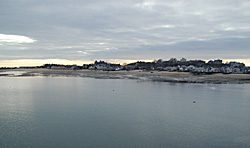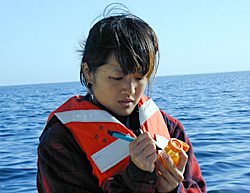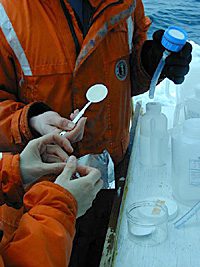The Boston Outfall Monitoring Project
 In March of 2005, the Center’s findings from its four-year study on the effects of the treated effluent from the Boston Outfall were reported to the Cape Cod Commission. The conclusion was that the outfall has had minimal impact on Cape Cod Bay and the food supply of the endangered North Atlantic right whale. In reporting the findings, however, Executive Director Peter Borrelli called upon the commission to adopt a precautionary approach to Cape Cod Bay by supporting continued research on potential long-term impacts of “upstream polluters” of the marine environment.
In March of 2005, the Center’s findings from its four-year study on the effects of the treated effluent from the Boston Outfall were reported to the Cape Cod Commission. The conclusion was that the outfall has had minimal impact on Cape Cod Bay and the food supply of the endangered North Atlantic right whale. In reporting the findings, however, Executive Director Peter Borrelli called upon the commission to adopt a precautionary approach to Cape Cod Bay by supporting continued research on potential long-term impacts of “upstream polluters” of the marine environment.
 In the spring of 2000, six months prior to the start-up of the multi-billion dollar project to clean up Boston Harbor, the Center announced that it had begun a careful study of possible nitrogen loading of Cape Cod Bay resulting from the average discharge of 350 million gallons a day of treated effluent from the Deer Island Treatment Plant into Massachusetts Bay. Despite intense public and scientific scrutiny of the project over the previous decade and the issuance of a stringent permit by the Environmental Protection Agency, the Cape Cod Commission, a small group of scientists (including PCCS Senior Scientist Dr. Charles “Stormy” Mayo, Dr. Theodore Smayda of the University of Rhode Island, and Dr. Joseph Montoya of Georgia Tech), and general public continued to express concern that Boston Harbor’s pollution problems might be passed on to Cape Cod.
In the spring of 2000, six months prior to the start-up of the multi-billion dollar project to clean up Boston Harbor, the Center announced that it had begun a careful study of possible nitrogen loading of Cape Cod Bay resulting from the average discharge of 350 million gallons a day of treated effluent from the Deer Island Treatment Plant into Massachusetts Bay. Despite intense public and scientific scrutiny of the project over the previous decade and the issuance of a stringent permit by the Environmental Protection Agency, the Cape Cod Commission, a small group of scientists (including PCCS Senior Scientist Dr. Charles “Stormy” Mayo, Dr. Theodore Smayda of the University of Rhode Island, and Dr. Joseph Montoya of Georgia Tech), and general public continued to express concern that Boston Harbor’s pollution problems might be passed on to Cape Cod.
 Cape Cod Bay Watch Prior to the start-up of the Boston Outfall, researchers at the Center developed a baseline profile of Cape Cod Bay by analyzing archived plankton samples dating to the early ’80s and collecting fresh samples. Then beginning in September 2000 when the outfall became operational, the Cape Cod Bay Monitoring Project employed a variety of Environmental Protection Agency (EPA) protocols to test for copepod density.
Cape Cod Bay Watch Prior to the start-up of the Boston Outfall, researchers at the Center developed a baseline profile of Cape Cod Bay by analyzing archived plankton samples dating to the early ’80s and collecting fresh samples. Then beginning in September 2000 when the outfall became operational, the Cape Cod Bay Monitoring Project employed a variety of Environmental Protection Agency (EPA) protocols to test for copepod density.
Tracking copepods, the dense plumes of zooplankton which form the basis of the right whale diet, became the scientific yardstick for measuring whether sewage-related nitrogen is damaging the Bay ecosystem. According to Center associate scientist Dr. Gregg E. Moore, who wrote the summary of findings, “Over longer periods of time, excess sewage-derived nutrients can be transported relatively unnoticed into Cape Cod Bay and the Stellwagen Bank National Marine Sanctuary and affect water quality, marine food webs, and foraging habitat for right whales.” The underlying concern of the Center and of the Cape Cod Commission, was that the design of the MWRA’s multi-million dollar monitoring program did not give adequate attention to Cape Cod Bay. The monitoring project attempted to correct this by collecting samples more frequently at more stations throughout Cape Cod Bay.
“Given the value of Cape Cod Bay and its resources, it was critical to confirm the effectiveness of the outfall design,” says Dr. Charles Mayo, Center Senior Scientist. “The results of our studies confirm that the design of the outfall was as effective as planned.” However, the study calls for additional research employing new criteria to assess potential long-term affects to the Bay.
Cape Cod Bay Watch The nine-mile-long outfall tunnel discharges treated sewage into Massachusetts Bay through a series of diffusers located in approximately 100 feet of water. The discharge point is about 36 miles from Cape Cod Bay. Before construction of the court-ordered tunnel, Boston Harbor was little more than an open sewer with massive quantities of untreated effluent discharging daily into the embayment. Borrelli, who is a member of the Public Interest Advisory Committee that helps to oversee the MWRA monitoring program, told the commission that “in a remarkably short time we have witnessed one of the major environmental cleanups in the nation. It is a cause for celebration. However, this would not have come about were it not for public concern and the attention to detail given the design of the project by many individuals and organizations throughout the region.”
The Center’s Cape Cod Bay Monitoring Project was funded in part by the Massachusetts Environmental Trust, Oak Foundation, Cape Cod Commission, and concerned citizens throughout the region.
The Center’s report on the study is available in its entirety in PDF format below.
“Effects of Boston Outfall on the Marine Community of Cape Cod Bay”
To learn more about the Boston Outfall Project and the Massachusetts Water Resources Authority please view their website:
http://www.mwra.state.ma.us/harbor/html/soh_outfall.htm


